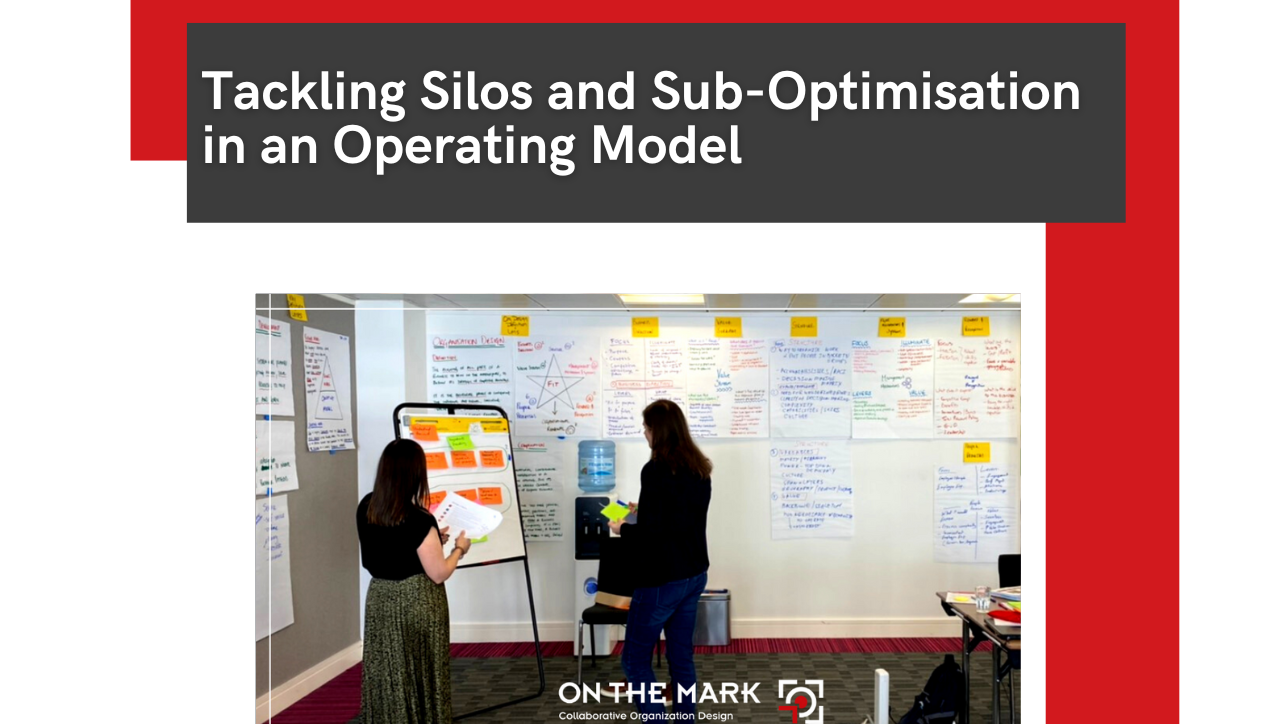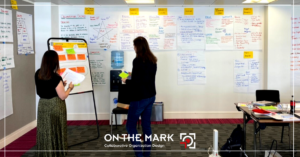5 Minute Read
Takeaway: You have to bring the social and technical system together to ensure the choices and implications of changing an operating model in one part of the business are understood elsewhere. This significantly accelerates adoption and impact (ROI) when designed jointly and concurrently.
One of the most enjoyable aspects of helping leaders and teams collaboratively redesign their business is the sheer variety of industry sectors and contexts we have the privilege of working in. Many folks will say “you must see the same issues and opportunities everywhere?” – yes, a few similarities, but actually an awful lot of differences as each context has many unique features and needs.
One topic that often comes up, and is a unifying discussion when you bring different teams from across a business together, is that of ‘optimisation’: how do we do the best with what we’re given in terms of resources to deliver our services, goals, and all the other stuff we are trying to do?
Central to this challenge are choices and consequences (both intended and unintended). Often a leader in one organisation boundary will want to optimise their part to meet the services, outputs, and goals they are tasked with delivering. Over time, as each individual boundary leader optimises their part, the overall whole is at risk of becoming fragmented and sub-optimised. One solution is to overlay a mechanism that sits above all boundaries, with a purpose of overseeing sub-boundary change requests, support the gearing between different boundaries and their ambition and constraints, and manage throughput.
Being on the Frontline: A Practical Example
One business decided to implement a mechanism that manages the integrity of the overall Enterprise operating model as it pertains to its strategy and service offering, maintaining integration of operational delivery and change/improvement opportunities. We call it “govern the design”. In this example, it is effective at aiding deconfliction, prioritisation and assessment of second and third order effects/consequences. This is of particular relevance as their business regularly experiences significant increases and decreases in demand, whereby their “business as usual” mode of operating is overmatched when the level of demand and complexity increases above a well-defined and monitored threshold.
But a design integrity and integration mechanism is no silver bullet solution for addressing the unintended consequences of local optimisation. The mechanism should help strengthen how the business responds to opportunities, not be focused on compensating for sub-optimisation and fragmentation.
The wisdom, as we dove deep on in our recent Masterclass, is to design for joint optimisation. You have to bring the social and technical system together to ensure the choices and implications of changing an operating model in one part of the business is understood elsewhere. This significantly accelerates adoption and impact (ROI) when designed jointly and concurrently. This doesn’t mean you can never get on with running ‘your’ part of the business; it simply means bringing a representation of the whole work system into the process so those implications are fully understand and adjustments are made for more seamless work integration.
Importantly, this is not after-the-event traditional change management, where a change in an operating model design is ‘done’ then briefed into various stakeholders and employees in tell-mode framed as stakeholder engagement (“we’re doing X, which means you now need to do Y”)
Returning to the previous example, the customer team referred to it as “too many tweaks and now we creek; bleeding together at the seams of our internal interfaces”.
The legacy operating model had become fragmented into very specialised functions that ran deep into many dozen narrowly specialised teams. For the context of what they do as a business, it is highly specialised services, but excessive effort and cost was being spent “gluing it up” with so much work and decisions being passed between many dozen teams.
To compensate for the fragmentation, management roles were created just to manage boundary pass-offs. Identification of errors and acceptance criteria was done before work was taken from one part to the other. Meeting culture had taken over where people spend their time, and the value delivered to customers (timeliness, quality and cost) had significantly dropped.
The unique thing about this business is they have to carry a certain amount of latent capacity and waste so when the business demand shoots above an agreed threshold, they can reconfigure how they work. The ineffectiveness came in how integrated this work was when moving up and down the demand gears.
The mechanism that would sit above the various boundaries would only get them so far.
They identified several more fundamental challenges when responding to changes in demand, including:
- Attempting to do the same things but faster is not possible in many cases and presented significant organisational and customer risk
- Buying out incoherence after-the-event is costly, and the existing solutions to operate at pace and scale caused burn out
- Low understanding of the end-to-end work processes and several critical assumptions in how the business copes above threshold
Fundamentally, the business was struggling to adapt to changes in demand “by-design.” Simply asking for more money and people to work faster/harder gets them by. The work system had also become overly reliant on escalating problems and risks during increased demand so someone else “higher up” could make the decision.
It was unsustainable.
The new operating model was developed and implemented by following the principle of joint optimisation. The social and technical system came together from all organisational boundaries and beyond (partners, suppliers etc) to co-design how the end-to-end work system would operate at different levels of demand.
Some of the features beyond the new integrating mechanism included:
- Co-created data modelling that made visible how the end-to-end network was operating with changes in demand, based on 15 agreed variables
- Scenario testing (through the design process and as a permanent cross-boundary activity) to regularly test and learn how the business changes its operating model in line with significant shifts in demand
- A corporate learning mechanism so when pushing the network to its limits (now and again), key learnings such as how people behave are used to improve the different ways of working, shifts in decision authority, and which levers to pull when demand changes
- A rebalance of specialised versus generalised work, with several horizontal/lateral processes and roles to provide continuous join up. This focused on solving the variances and risks as close to the source as possible, reducing the effort and burden to escalate and manage excessive decision making.
One impact “joint optimisation” as a design principle brought to the process was a shared language and understanding on the tipping point across the business, beyond which a differentiated response is required.
The integration challenge is about putting in place the practical ways of working that successfully link all parts of an enterprise. This addresses the risk of unnecessary cost, risk, and poor-quality outputs which are caused by a fragmented and sub-optimised operating model. Whilst well intended, no leader, team or organisational boundary is an island – it would benefit every team and leader to think and act more with joint optimisation (“we, not me”).
Chris Furnell is a Senior Consultant at ON THE MARK. OTM is a global leader in collaborative operating model modernization that creates real change, fast. OTM’s passion for collaborative business transformation is supported by pragmatism, systems thinking, and a belief in people that is unparalleled for 33 years.




